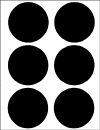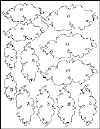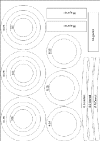 |
How to Specify a Color
Hue (color), value (lightness), and chroma (intensity) are characteristics used
to describe tile appearance of all individual color. It is often useful to think
of it as a three dimensional color space.
Either Subtractive or Additive methods can create colors. The simplest example
to demonstrate Additive methods is the Television where primary colors of Red,
Green and Blue are mixed to produce white light and other spectral variants.
Process printing uses a subtractive method where the Secondary colors of Yellow,
Magenta, Cyan are combined to produce a theoretical black. Due to impurities the
result is muddy in appearance and a fourth black printer is added to darken
shadow areas and add contrast.
Color Wheels
One of the special challenges related to vitreous transfers is the prediction of
the final color appearance after firing. Color wheels are decals printed with a
variety of colors representing a broad range of available colors within a frit
system. They are used for making tests on different substrates and firing
variables to specifying color. We have developed standard color pallets for
glass, ceramic over-glaze, and ceramic in-glaze firing temperatures. These colors
are presented on their respective color wheels for ease of selection and firing
tests. Color wheel decals for each of the three pallets are available upon
request.
![]()
This award winning team of artists and designers was assembled in
response to the growing need for innovative and affordable graphics for the
glass and ceramic industries. Their talents and creative styles are a resource
for clients who want to take their ideas to the next phase of development; rough
sketches or full color comps. From here detailed pencil sketches are produced,
refined and then rendered as final art. The process includes integrated feedback
and a client-approved outline. Our artists are industry aware, reducing the
possibility of contracting for art which is not translatable to Your specific
needs.
Uniform- Regular rows and columns of a single item.

Compound- Variation of sizes and shapes.

Embedded- Compound layout where decals fit inside each other

Color Separation Options
The following identifies three major categories of artwork and describes the
color separation techniques most closely related to them. It is offered in
response to your many requests for a guideline to use when evaluating the
options related to ceramic decal reproduction. Although the principles are
fundamentally valid for most printing processes, please understand that this is
a simplification. In practice, artwork, often does not fall into a discreet
category. In those cases, a multitude of variations that are well beyond the
limited scope of this discussion are required.
Line Art
Graphic presentation of subjects with clearly defined areas of solid colors with little or no tonal variation.
Paintings
Artwork produced by the application of multiple shades of color, blended together
Photographs.
A likeness obtained by photography; continuous tone images.
Mechanical
Printing of one or more drawings or hand cut stencils that define the relative placement of each solid color. Examples- Cartoons, logos.
Photo- Mechanical
Printing combinations of solid and toned art together that create an interpretation of the original . This can employ halftones, pointillism, posterization, or stipple techniques to create shadows and highlights or intersperse dots to blend into new tones. Examples- Textile prints and floral, Serigraphs and Art Prints.
Process
Printing of subtractive tones of the 4 primary colors, usually from laser scanned electronically produced separations to create a reproduction of the original but may include discrete enhancement individual colors and or digital manipulation of composition. Examples-Fine Art Reproduction, Collector Plates.
Advantages / Limitations of the Separation TechniquesMechanical is most economical for up to 5 or 6 colors. Bright solid colors work best. Easy to match local color. Simple to produce multiple color variations.
Photomechanical makes it, simple to print multiple color variations using the same art and separations. It is often less costly to engineer multiple size adaptations without creating new original artwork. Elaborate artwork can require 15 colors or more causing both separation and printing costs to rise dramatically.
Process is the most faithful Graphic reproduction of original artwork. The manipulation of size and or color may require new art and or photography. Recent technology permits impressive new opportunities but cost is a significant factor. It is most difficult to match local color without adding additional color imprints.
We can work from concept sketches, ideas, or descriptive text
but "camera ready" is a term that we use to describe any art work that
is presented in a manner that can be directly photographed without other
composition, preparation, or manipulation. Line art does not need to be actual
size, as long as it is to scale (larger is generally better than smaller). We
can support Your art or development needs from virtually any level you desire,
but art supplied in camera ready form usually requires fewer questions and
alterations, resulting in faster service and reduced cost. For a complete
discussion on types of art work and color separation techniques, please refer
to: "Color Separation Options."
Films
Film Positive- emulsion up, right read or film Negative- emulsion down, right
read.
Dot Angle
Yellow 90° Y Magenta 45° Y Cyan 105° Y Black 75°
Film size should comply with the print area of one of our three sheets; 10x13
(9x12) • 13x20 (12x19) • 20x26 (19x25). 300dpi is the preferred resolution
for process work. The line count for halftone work should be either 100, 120 or
150-line screen. 150 line should be used for collector quality process work or
any art with fine line detail. 120 line is a standard line count for halftone
graphics not requiring fine detail and line art with gradated tones. Line art
without gradated tones or fine line detail can be reproduced using a 100-line
screen. Hard copy or
Match-print must accompany all films.
Some basic rules to follow when preparing separations requiring spot colors are
as follows. Gold and cadmium bearing colors must be knocked out of process
yellow and magenta to avoid contamination between the frit systems. In most
cases cyan and black can still be overprinted for shadowing. Precious metals
must be spread and printed first. Dot angle for spot colors is determined by the
process color's) it is replacing. All images are unique to some extent when
dealing with spot colors for enhancement of the image.
We will review your art and supply detailed instructions as to the treatment of
spot colors or perform the required work on our computer systems.
Proofing can be accomplished in a number of ways including the
printing of a short run which produces a physical sample of the decal creating a
standard to which all future printing editions would be compared. Other options
include Digital Color Proofs and a special variation which we term a Photo-call™
a non-firing decal.
Photo-call is a computer generated full color, cold application, water slide off
decal. It can be produced very quickly, in small quantities, at a very
reasonable cost. Multiple iterations and almost unlimited freedom in image
editing are also possible. It is ideal for models, photography samples,
prototypes, trade show samples, dinnerware fits, focus group testing, proofs,
and a host of other product development needs.
Changes in size, color, or composition can be selectively and easily
accomplished creating the advantage of being able to see and test multiple
iterations on your product prior to committing to production of decals or
decorated product. We can't imagine more unlimited freedom with image editing or
flexible options.
We can work from your drawing, transparency, or electronic data. We can handle a
broad range of media including all popular magnetic floppy discs, 44 Mb or 45 Mb
cartridges, optical discs, high speed modem, and more.
Modern screen-printing typically uses a photographic stencil which covers the
non image areas. This leaves image areas open to accept ink. The screen material
is usually a monofilament fabric of either polyester or stainless steel.
Printing is accomplished by forcing the ink through the screen area with a
rubber or urethane squeegee. Heavy ink consistency and course halftones can
restrict reproduction quality. Recent developments now permit fine halftone
rulings of 150 line and greater. Screen-printing offers higher coating thickness
than lithography, which results in consistent and reliable results, needed for
today's textures and other varied aesthetic appearances. Ink thickness is
controlled by screen mesh, stencil thickness, ink formulation and press
adjustments.
Uni-Mark™ decals are applied onto bisque ware with the help
of a bonding solution. The ware is then glazed and the piece is fired. Uni-Mark™
can be applied over raw glaze as well. Either way, the result is a once fired
product with a permanent decoration and glaze.
Application to bisque ware
A bonding solution is brushed or sprayed onto the bisque ware so the surface
of the ware will be less porous. This allows the decal to adhere to the surface
. Uni-Mark™ decals are applied to the treated bisque through traditional
water-slide methods (See Vitrical™
for additional application information). It is very important that the decal be
applied to the ware while the bonding solution is still wet. The decal must then
be squeezed to ensure there are no air pockets between the decal and solution.
Once the decal is in place, any excess solution should be removed with a soft
cloth. Bonding solution is available through most ceramic vendors. Once the
decal has been applied, the ware should be allowed to stand for twelve hours to
assure proper adhesion. There is an interaction between the bonding solution and
cover-coat of the decal. The effect is to soften the cover-coat, causing
adhesion between the transfer and the bisque. After twelve hours, the ware is
ready for glazing. In order to help the glaze completely cover the cover-coat of
the decal, it is essential to use a wetting agent in the glaze. The additive
should be between 1/2 and I% by weight to the slop weight of the glaze.
Application to raw glaze
Uni-Mark™ decals can also be applied to raw glaze. The glaze is applied to
the bisque ware and allowed to dry. The glaze surface will need to be sealed
with a binder as well. Uni-Mark™ decals are then applied over the raw glaze as
described previously.
Firing
Once Uni-Mark™ decals have been applied and allowed to dry, the ware, decal,
and glaze are then matured in a single firing. The time/temperature curve of the
firing cycle will depend on the type of ware and glaze that you are using (See
Proper Firing). Normally, the temperature range of the decals is between 1800
and 2000°F.
These water-slide decals will create an embossed or relief
appearance to glazed china, pottery, and tile. The embossed area can be colored
to fit your specific needs. MIGRA-CAL™ decals are designed to be applied to
the fired glaze surface of your ware. They should then be re-fired in the range
of 1800-2000° F., depending upon glaze composition and the amount of relief you
want to achieve. The intensity of relief produced by this product is both a
function of glaze composition and firing temperature. Several trial runs may be
required to achieve the desired effect; however, repeatability is quite reliable
as long as temperature and glaze composition are consistent. This effect is
achieved because the materials used in the decal change the wetting
characteristics of the glaze. The result is that the glaze will pull away from
the decorated surface areas. The decorated surface will present depressed
features in decal image areas, thereby producing an embossed or glaze relief in
the non-image areas. This type of effect is especially useful for architectural
purposes.
MIGRA-CAL™ decals are applied onto glazed ware using traditional
water-slide/squeegee methods (for more information on application, see
Vitrical™).
Once dry, the decals are then fired producing an embossed effect.
Phone: Phone:
(215) 493-8449 Fax:
(215) 325-0137
PO BOX 28 Morrisville, Pa
19067
E-mail
2004
MOLFRAN LLC